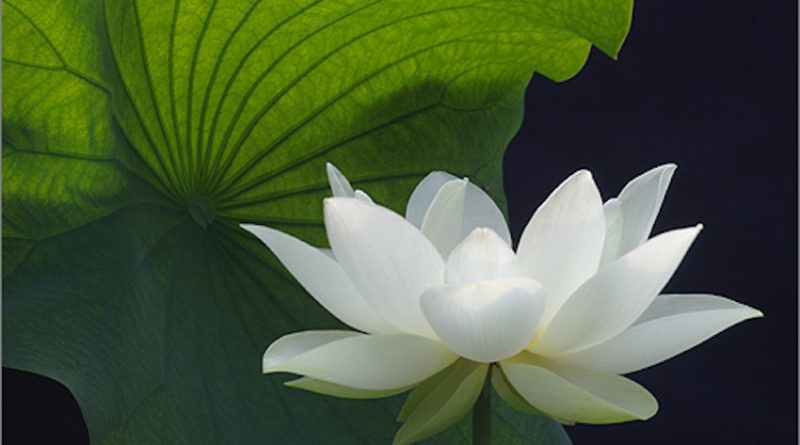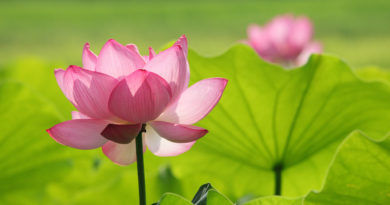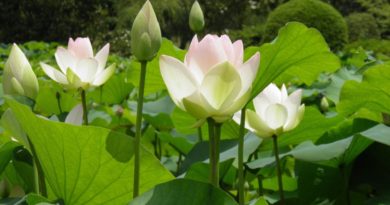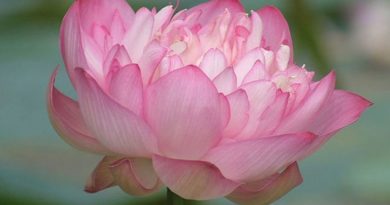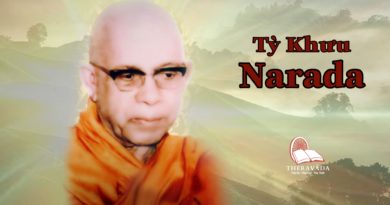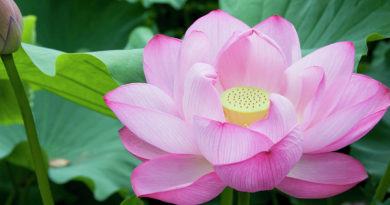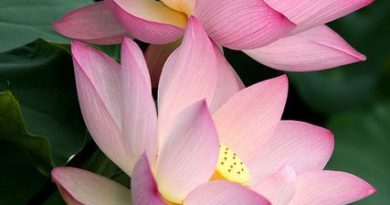ABHIDHAMMA IN DAILY LIFE – CHAPTER 18: ELEMENTS
ABHIDHAMMA IN DAILY LIFE – CHAPTER 18: ELEMENTS
The Buddha spoke about realities as elements in order to remind us that they are impermanent and not self. When we speak about elements we usually think of the elements in chemistry or physics which have each their own characteristics. In chemistry and physics matter is analysed into elements, but it may seem strange to us to regard the eye or seeing as elements. We are not used to consider them as elements because we are inclined to take them for ‘self’.
What we take for self are only nama-elements and rupa-elements which arise because of their appropriate conditions and then fall away again. Eyesense is only an element which has its own characteristic and is devoid of self ; it is rupa which arises because of conditions and then falls away again. Seeing is only an element which has its own characteristic and is devoid of self ; it is nama which arises because of conditions and falls away again.
ln the Buddha’s teachings realities are classified as elements, some of which are rupa and some of which are nama. When they are classified as eighteen elements; they are as follows:
The five senses:
- eye-element (cakkhu-dhatu)
2. ear-element (sota-dhatu)
3. nose-element (ghana-dhatu)
4. tongue-element (jivha-dhatu)
5. body-element (kaya-dhatu) which is the body-sense
The five objects (experienced through the five senses):
- visible object-element (rupa-dhatu)
7. sound-element (sadda-dhatu)
8. smell-element (gandha-dhatu)
9. taste-element (rasa-dhatu)
10. element of tangible objects (photthabba-dhatu),
comprising the following three kinds of rupa:
earth-element (solidity), appearing as hardness or softness
fire-element (temperature), appearing as heat or cold
wind-element, appearing as motion or pressure
The dvi-panca-vinnanas (experiencing the five sense objects):
- seeing-consciousness-element (cakkhu-vinnana-dhatu)
12. hearing-consciousness-element (sota-vinnan-adhatu)
13. smelling-consciousness-element (ghana-vinnana-dhatu)
14. tasting-consciousness-element (jivha-vinnana-dhatu)
15. body-consciousness-element (kaya-vinnana-dhatu)
Three more elements:
- mano-dhatu or mind-element
17. dhamma-dhatu
18. mano-vinnana-dhatu or mind-consciousness-element
The five elements which are the five sense-doors are rupa and the five elements which are the objects experienced through the sense-doors are rupa as well. The five elements which are the dvi-panca-vinnanas, experiencing these objects, are nama. There are two cittas which are cakkhu-vinnana-dhatu, since seeing-consciousness can be kusala vipaka or akusala vipaka. It is the same with the other panca-vinnanas. Thus there are ‘five pairs’ of citta which are panca-vinnana-dhatu.
The element which is mano-dhatu or mind-element is nama. Mano-dhatu comprises the panca- dvaravajjana-citta (five-sense-door-adverting-consciousness) and the two types of sampaticchana-citta (receiving-consciousness) which are kusala vipaka and akusala vipaka. Thus three kinds of citta are mano-dhatu.
Dhamma-dhatu comprises both nama and rupa. Dhamma-dhatu is the cetasikas, the subtle rupas (sukhuma-rupas) and nibbana.
Mano-vinnana-dhatu or mind-consciousness-element is nama. It comprises all cittas which are not the dvi-panca-vinnanas and not mano-dhatu. For example, santirana- citta (investigating-consciousness), mano-dvaravajjana-citta (mind-door-adverting-consciousness) and the cittas performing the function of javana such as lobha-mula-citta are mano-vinnana-dhatu.
Panca-vinnana-dhatu (seeing-consciousness-element, etc.), the mano-dhatu (mind-element) and the mano-vinnana-dhatu (mind-consciousness-element) are: vinnana-dhatu (consciousness-element).
Dhamma-dhatu is not identical with dhammarammana (mind-objects). Cittas are included in dhammarammana, but not in dhamma-dhatu, since dhamma-dhatu is: cetasikas, subtle rupas and nibbana. When cittas are classified as elements they are the seven classes of vinnana-dhatu, namely:
Panca-vinnana-dhatu (which are five classes), mano-dhatu (mind-element), mano-vinnana-dhatu (mind-consciousness-element).
Concepts and conventional terms (pannatti) which are included in dhammarammana are not dhamma-dhatu, because they are not paramattha dhammas. Only paramattha dhammas are classified as elements.
Sometimes the Buddha spoke about six elements ; or he classified realities as two elements. There are many different ways of classifying realities, but no matter in which way realities are classified, as khandha, by way of arammana (objects), or in any other way, we should remember the purpose of classifying realities : realizing that what we take for self are only nama-elements and rupa-elements.
In the ‘Satipatthana-sutta’ (Discourse on the Applications of Mindfulness, Middle Length Sayings I, No.10) we read in the section about mindfulness of the body, that the Buddha spoke about the body in terms of elements. The text states:
And again, monks, a monk reflects on this body according to how it is placed or disposed in respect of the elements, thinking: ‘In this body there is the element of extension (solidity), the element of cohesion, the element of heat, the element of motion.’ Monks, even as a skilled cattle-butcher, or his apprentice, having slaughtered a cow, might sit displaying its carcass at a cross-roads, even so, monks, does a monk reflect on this body itself according to how it is placed or disposed in respect of the elements, thinking: ‘In this body there is the element of extension, the element of cohesion, the element of heat, the element of motion’. Thus he fares along contemplating the body in the body internally…and he fares along independently of and not grasping anything in the world. It is thus too, monks, that a monk fares along contemplating the body in the body…
The ‘Visuddhimagga’ (XI, 30) states:
What is meant? Just as a butcher, while feeding the cow, bringing it to the shambles, keeping it tied up after bringing it there, slaughtering it, and seeing it slaughtered and dead, does not lose the perception ‘cow’ so long as he has not carved it up and divided it into parts ; but when he has divided it up and is sitting there, he loses the perception ‘cow’ and the perception ‘meat’ occurs ; he does not think ‘I am selling cow’ or ‘They are carrying cow away’, but rather he thinks ‘I am selling meat’ or ‘They are carrying meat away’; so too this bhikkhu, while still a foolish ordinary person–both formerly as a layman and as one gone forth into homelessness–, does not lose the perception ‘living being’ or ‘man’ or ‘person’ so long as he does not, by resolution of the compact into elements, review this body, however placed, however disposed, as consisting of elements. But when he does review it as consisting of elements, he loses the perception ‘living being’ and his mind establishes itself upon elements….
It may not be appealing to see the body as elements. We think of people as ‘this man’ or ‘that woman’. We are not used to analysing what we take for a ‘person’ in the way we analyse matter, as we do, for example in physics. One might find it crude to think of a body carved up as a cow is carved up by a butcher. However, if we consider the body as it is, there are only elements. Isn’t it true that there are solidity, cohesion, temperature and motion? Are these realities ‘self’, or are they elements devoid of ‘self’?
Do the four elements of solidity, cohesion, temperature and motion have anything to do with our daily life? These elements arise all the time. Temperature can appear either as heat or cold; do we not feel heat or cold very often? When we are stung by an insect we can experience the characteristic of heat. We can feel impact of hardness or softness on our body when we are lying down, sitting, walking or standing. Is that not daily life? If we are mindful of the characteristics of the elements more often, we will see things as they are.
The Buddha reminded people of the truth in many different ways. Sometimes he spoke about the body as a corpse in different stages of dissolution. Or he spoke about the ‘parts of the body’ and he explained how the body is full of impurities, in order to remind people that what we take for our body are only elements which are devoid of beauty, which are dukkha, impermanent and not self.
We read in the ‘Satipatthana-sutta’, in the section about mindfulness of the body:
Monks, it is like a double-mouthed provision bag that is full of various kinds of grain such as hill-paddy, paddy, kidneybeans, peas, sesame, rice; and a keen-eyed man, pouring them out, were to reflect: ‘That’s hill-paddy, that’s paddy, that’s kidneybeans, that’s peas, that’s sesame, that’s rice.’ Even so monks, does a monk reflect on precisely this body itself, encased in skin and full of various impurities, from the soles of the feet up and from the crown of the head down…
Not only the body, but also the mind should be considered as elements. There is nothing in our life which is not an element. Our past lives were only elements and our future lives will only be elements. We are inclined to think of our future life and wish for a happy rebirth. We should, however, realize that there is no self which in the future will have another existence ; there are and will be only elements. We have learned to classify citta in different ways and this reminds us that cittas are only elements. Not only cittas are elements, but cetasikas too are elements. We are attached to happy feeling and we dislike unpleasant feeling. Feelings, however, are only elements, which arise because of conditions. When we are tired or sick we take tiredness and sickness for self and we have aversion. Why do we not accept unpleasant things as they come to us, since they are only elements? One might not be inclined to see realities as elements, but it is the truth. One might not like to remember that things are impermanent, that birth is followed by ageing, sickness and death, but it is the truth. Why do we not want to see the truth?
In the ‘Discourse on the Manyfold Elements’ (Middle Length Sayings III, 115) we read that the Buddha, while he was staying in the Jeta Grove, in Anathapindika’s monastery, said to the monks that fears, troubles and misfortunes occur to the fool, not to the wise man. He said to the monks:
‘…Monks, there is not fear, trouble, misfortune for the wise man. Wherefore, monks, thinking, ‘Investigating, we will become wise’, this is how you must train yourselves, monks.’
When this had been said, the venerable Ananda spoke thus to the Lord: ‘What is the stage at which it suffices to say, revered sir: ‘Investigating, the monk is wise’?’ ‘Ananda, as soon as a monk is skilled in the elements and skilled in the (sense) fields and skilled in conditioned genesis and skilled in the possible and the impossible, it is at this stage, Ananda, that it suffices to say, ‘Investigating, the monk is wise.”
‘But, revered sir, at what stage does it suffice to say, ‘The monk is skilled in the elements’?’
‘There are these eighteen elements, Ananda: the element of eye, the element of material shape, the element of visual consciousness; the element of ear, the element of sound, the element of auditory consciousness ; the element of nose, the element of smell, the element of olfactory consciousness ; the element of tongue, the element of taste, the element of gustatory consciousness; the element of body, the element of touch, the element of bodily consciousness; the element of mind, the element of mind-objects, the element of mental consciousness. When, Ananda, he knows and sees these eighteen elements, it is at this stage that it suffices to say, ‘The monk is skilled in the elements.’ ‘
‘Might there be another way also, revered sir, according to which suffices to say, ‘The monk is skilled in the elements’?’
‘There might be, Ananda. There are these six elements, Ananda: the element of extension, the element of cohesion, the element of radiation, the element of mobility, the element of space, the element of consciousness. When, Ananda, he knows and sees these six elements, it is at this stage that it suffices to say, ‘The monk is skilled in the elements.” ‘Might there be another way also, revered sir, according to which it suffices to say, ‘The monk is skilled in the elements’?’
‘There might be, Ananda. There are these six elements, Ananda: the element of happiness, the element of anguish, the element of gladness, the element of sorrowing, the element of equanimity, the element of ignorance. When, Ananda, he knows and sees these six elements, it is at this stage that it suffices to say, ‘The monk is skilled in the elements.”
The Buddha then explained still other ways of being skilled in the elements and further on we read that Ananda asked again :
‘Might there be another way also, revered sir, according to which it suffices to say, ‘The monk is skilled in the elements’?’
‘There might be, Ananda. There are these two elements, Ananda: the element that is constructed and the element that is unconstructed. When, Ananda, he knows and sees these two elements, it is at this stage that it suffices to say, ‘The monk is skilled in the element.
The element which is constructed is all conditioned realities (the five khandhas), and the element which is unconstructed is nibbana. Also nibbana is an element, it is devoid of self. Nibbana is not a person, it is anatta. We read in this sutta about the monk who knows and sees the elements. Knowing and seeing the elements does not mean only knowing them in theory and thinking about them. One knows and sees the elements when panna realizes nama and rupa as they are: only elements, not self. This knowledge will lead to the end of ‘fears, troubles and misfortunes’.
-ooOoo-
Questions
- When realities are classified as eighteen elements, what element is cetasika?
2. Which paramattha dhammas are vinnana-dhatu (consciousness-element)?
3. Is mano-vinnana-dhatu (mind-consciousness-element) included in vinnana-dhatu?
4. Through how many doors does mano-dhatu experience an object?
5. Why is also nibbana an element?

